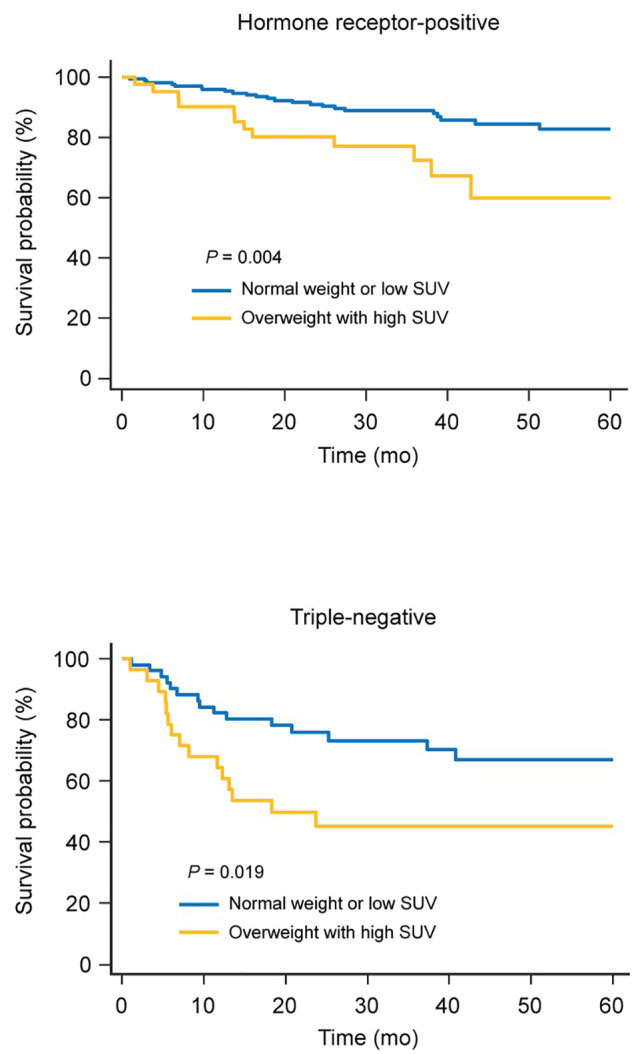글로벌 연구동향
핵의학
![[PLoS One.] Body Mass Index with Tumor 18F-FDG Uptake Improves Risk Stratification in Patients with Breast Cancer.](/enewspaper/upimages/admin_20161214134639_R.jpg) 2016년 12월호
2016년 12월호
[PLoS One.] Body Mass Index with Tumor 18F-FDG Uptake Improves Risk Stratification in Patients with Breast Cancer.성균관의대 / 현승협, 안희경, 이경한*
- 출처
- PLoS One.
- 등재일
- 2016 Oct 31
- 저널이슈번호
- 11(10):e0165814. doi: 10.1371/journal.pone.0165814. eCollection 2016.
- 내용

Abstract
PURPOSE:
To investigate the combined prognostic impact of body mass index (BMI) and tumor standardized uptake value (SUV) measured on pretreatment 18F-fluorodeoxyglucose positron emission tomography/computed tomography (FDG PET/CT) in patients with breast cancer.
METHODS:
We evaluated a cohort of 332 patients with newly diagnosed breast cancer (stage I-III) who underwent pretreatment FDG PET/CT followed by curative resection. Patients were categorized as overweight (BMI ≥ 23 kg/m2) or normal weight (BMI < 23 kg/m2). Primary tumor maximum SUV was measured by FDG PET/CT. Associations between BMI and tumor SUV with disease recurrence were assessed using Cox regression models.
RESULTS:
Median follow-up was 39 months. There were 76 recurrences and 15 cancer-related deaths. Multivariable Cox regression analysis demonstrated that high tumor SUV (hazard ratio [HR] = 1.75; 95% CI, 1.02-3.02; P = 0.044) and overweight (HR = 1.84; 95% CI, 1.17-2.89; P = 0.008) were independent poor prognostic factors. Positive hormone receptor status was an independent predictor of favorable outcome (HR = 0.42; 95% CI, 0.26-0.68; P < 0.001). Overweight patients with high tumor SUV had a two-fold risk of recurrence compared to patients with normal weight or low tumor SUV after adjusting for clinical stage and tumor subtype (HR = 2.06; 95% CI, 1.30-3.27; P = 0.002).
CONCLUSIONS:
In patients with breast cancer, higher tumor SUV was associated with a more adverse outcome particularly in overweight women. BMI status combined with tumor SUV data allows better risk-stratification of breast cancer, independent of clinical stage and tumor subtype.
Author information
Hyun SH1, Ahn HK2, Lee JH1, Choi JY1, Kim BT1, Park YH3, Im YH3, Lee JE4, Nam SJ4, Lee KH1.
1Department of Nuclear Medicine, Samsung Medical Center, Sungkyunkwan University School of Medicine, Seoul, Republic of Korea.
2Division of Hematology and Oncology, Department of Internal Medicine, Gachon University Gil Medical Center, Incheon, Republic of Korea.
3Division of Hematology-Oncology, Department of Medicine, Samsung Medical Center, Sungkyunkwan University School of Medicine, Seoul, Republic of Korea.
4Division of Breast and Endocrine Surgery, Department of Surgery, Samsung Medical Center, Sungkyunkwan University School of Medicine, Seoul, Republic of Korea.
- 연구소개
- 기존에 유방암에서 PET 영상 biomarker로서 종양의 FDG 섭취정도(SUV)가 환자 예후와 밀접한 관련이 있다는 연구들은 많이 보고되어 왔지만 환자의 비만도(BMI)에 따라 SUV의 예후적 가치는 달라질 수 있다는 최초의 보고로서 의미가 있는 연구입니다.
- 덧글달기
- 이전글 [Eur J Nucl Med Mol Imaging.] 18F-FDG PET/CT imaging factors that predict ischaemic stroke in cancer patients.
- 다음글 [Nucl Med Biol.] Comparative evaluation of 4 and 6-carbon spacer conformationally flexible tetrahydroisoquinolinyl benzamide analogues for imaging the sigma-2 receptor status of solid tumors.








편집위원
Metabolic dissease와 Cancer의 발생 또는 Metabolic disease와 Cancer의 예후와의 관계는 여러 가지 상황에서 관심을 받고 있는 상황입니다.
덧글달기닫기2016-12-06 09:26:12
등록
편집위원
당뇨병에 사용하던 약이 종양의 치료에 이용되고 있듯이.. 여러 생활습관등과 종양의 관계 규명은 종양 발생과 진행에 관여하는 환경적 요인를 규명하는데 큰 도움이 될 것으로 보입니다.
2016-12-06 09:26:12
편집위원2
다양한 종양에서 FDG PET/CT로 얻어진 SUVmax가 예후예측에 유용함이 널리 알려져 있는데, Body mass index도 SUVmax의 예후인자로서의 영향에 영향을 준다는 것을 보여준 임상연구 논문입니다.
2016-12-06 09:26:12
편집위원2
임상핵연구자에게 새로운 관점을 제공한 새로운 시각의 논문입니다.
2016-12-06 09:26:12